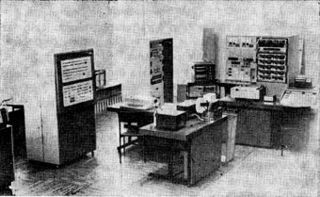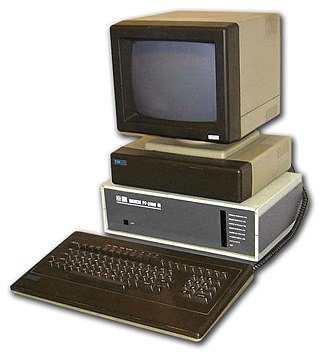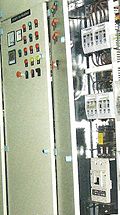
Mihajlo Idvorski Pupin, also known as Michael Pupin, was a Serbian-American electrical engineer, physicist and inventor.

The Galaksija was a build-it-yourself computer designed by Voja Antonić. It was featured in the special edition Računari u vašoj kući of a popular eponymous science magazine, published late December 1983 in Belgrade, Yugoslavia. Kits were available but not required as it could be built entirely out of standard off-the-shelf parts. It was later also available in complete form.

CER model 10 was a vacuum tube, transistor and electronic relay based computer developed at IBK-Vinča and the Mihajlo Pupin Institute (Belgrade) in 1960. It was the first digital computer developed in SFR Yugoslavia, and in Southern Europe.

CER model 22 is a transistor based computer developed by Mihajlo Pupin Institute (Serbia) in 1967-1968. It was originally intended for banking applications and was used for data processing and management planning in banks, trade and utility companies in Belgrade. Three CER-22 computers were purchased by Beobanka, Jugopetrol and BVK–Belgrade companies..
CER was a series of early computers developed by Mihajlo Pupin Institute in Yugoslavia in the 1960s and 1970s.

Mihajlo Pupin Institute is an institute based in Belgrade, Serbia. It is named after Mihajlo Idvorski Pupin and is part of the University of Belgrade.

CER model 12 was a third-generation digital computer developed by Mihajlo Pupin Institute (Serbia) in 1971 and intended for "business and statistical data processing". However, the manufacturer also stated, at the time, that having in mind its architecture and performance, it can also be used successfully in solving "wide array of scientific and technical issues". Computer CER-12 consisted of multiple modules connected via wire wrap and connectors.

The Socialist Federal Republic of Yugoslavia (SFRY) was a socialist country that existed in the second half of the 20th century. Being socialist meant that strict technology import rules and regulations shaped the development of computer history in the country, unlike in the Western world. However, since it was a non-aligned country, it had no ties to the Soviet Bloc either. One of the major ideas contributing to the development of any technology in SFRY was the apparent need to be independent of foreign suppliers for spare parts, fueling domestic computer development.

HRS-100, ХРС-100, GVS-100 or ГВС-100, was a third generation hybrid computer developed by Mihajlo Pupin Institute and engineers from USSR in the period from 1968 to 1971. Three systems HRS-100 were deployed in Academy of Sciences of USSR in Moscow and Novosibirsk (Akademgorodok) in 1971 and 1978. More production was contemplated for use in Czechoslovakia and German Democratic Republic (DDR), but that was not realised.

The TIM-100 was a PTT teller microcomputer developed by Mihajlo Pupin Institute (Serbia) in 1985, part of the TIM series of microcomputers.

CER model 203 is an early digital computer developed by Mihajlo Pupin Institute (Serbia) in 1971. It was designed to process data of medium-sized businesses:

TIM 011 is an educational or personal computer for school microcomputer developed by Mihajlo Pupin Institute of Serbia in 1987. There were about 1200 TIM-011 computers in Serbian schools in the starting from 1987 and in 1990s.

TIM-001 was an application development microcomputer developed by Mihajlo Pupin Institute (Serbia) in 1983/84.
Miroslav Marcovich was a Serbian-American philologist and university professor.

Vasilije "Vasa" Živković (1819–1891) was a Serbian poet and Orthodox priest. He is highly regarded in Serbian culture for his role in collecting verses from oral traditions of his people. His literary opus sustained only half of his poems to be printed since he was prone to self-criticism. His contemporaries were poets Jovan Ilić, father of Vojislav Ilić, Stevan Vladislav Kačanski, and many others.

TIM-600 was an important PC computer system in the TIM series of microcomputers from Mihajlo Pupin Institute-Belgrade, developed from 1987 to 1988. It was based on the Intel microprocessor types 80386 and 80387. It has word-length of 32 bits, basic cycle time of 20 MHz and operating system Unix V.3. The TIM-600 computer system was presented at the Munich International Computer Exhibition in September 1988.

CER-11 was a portable digital military computer, developed at Institute Mihajlo Pupin, located in Serbia, in a period between 1965 and 1966.
The Serbian Cultural Club was a short-lived but influential grouping of mainly Belgrade-based Serb intellectuals of the Kingdom of Yugoslavia in the years immediately before the outbreak of World War II. The organization pushed for the advance of Serbian national interest in Yugoslavia, following Croatian autonomy (1939). After the invasion of Yugoslavia in April 1941, the president of the SKK, Slobodan Jovanović went into exile with the government, but several members remained behind in Yugoslavia and developed a Serb-centric ideological framework for the Chetniks of Draža Mihailović.
Svetozar Radojčić was a Serbian art historian and academic. He played an important part in establishing the method of iconology in the second part of the 20th century.















